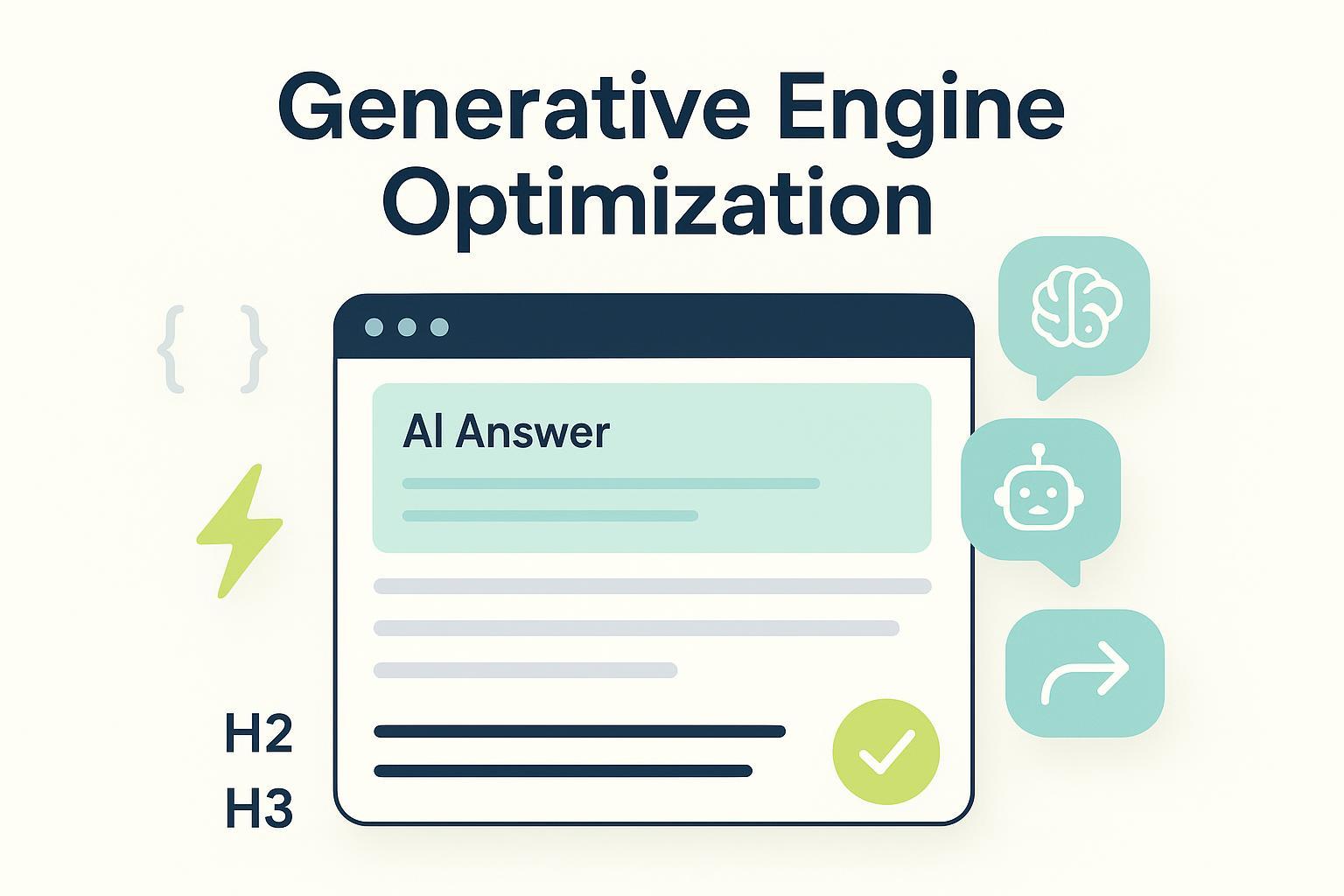GEO for Beginners: Practical Guide to Generative Engine Optimization
Start with GEO using this clear beginner guide. Learn how to appear in AI answer engines like ChatGPT, Perplexity, and Gemini, with practical tips and routines.


If you’re new to Generative Engine Optimization (GEO), here’s the deal: GEO is the practice of making your content easy for AI answer engines—like ChatGPT, Perplexity, Gemini/Google AI Overview, and Bing Copilot—to understand, summarize, and cite. Your aim isn’t just “rank #1” on a traditional SERP; it’s to be named as a source inside the answer itself. In the next two weeks, you’ll set up the basics, test prompts across engines, and start a repeatable routine that can earn your first citation. No guarantees—just a clear, practical path.
What GEO Is—and How It Differs from SEO and AEO
GEO focuses on appearing as a cited, trusted source in AI-generated answers. While SEO is primarily about ranking links on search results, and AEO (answer engine optimization) centers on structured, direct answers for snippets, GEO spans multiple AI engines and favors content that’s clear, well-structured, and credible. For a concise introduction, see Search Engine Land’s overview in What is generative engine optimization (GEO)? (2024), which frames GEO around AI answer engines and citations: Search Engine Land’s GEO definition and context. For a beginner-friendly rundown of emerging practices, HubSpot summarizes core tactics and uncertainties in Generative engine optimization: What we know so far (2025).
Why GEO Matters Right Now
AI answers are increasingly where users get their “first read.” These engines synthesize several sources, show a tight summary, and often link to references directly. If your brand is absent at the moment answers form, you miss awareness and potential demand that never reaches a traditional results page. Google’s guidance stresses fundamentals like indexable content and accessibility rather than magic switches—helpful for GEO thinking because it reminds us to prioritize clarity, structure, and discoverability. See Google’s ‘Succeeding in AI Search’ (2025) for the platform’s high-level direction (no guarantees implied).
How AI Engines Choose and Cite Sources (Beginner View)
Think of AI answer engines as careful summarizers. They prefer sources that are easy to parse and credible, then surface a compact explanation with supporting links.
- ChatGPT (with browsing): When browsing is available, ChatGPT pulls from the web and blends results with its internal knowledge. It may show inline references or list sources after the answer. Independent testing explains how “AI modes” select and attribute sources; see iPullRank’s analysis of how AI Mode works (2025) for a plain-language breakdown.
- Perplexity: Designed to be citation-forward. It typically highlights sources prominently and favors clear, authoritative material (technical docs, reputable publishers). Neutral reviews and tests consistently note this behavior; for a broad feature comparison across engines, see our platform comparison.
- Gemini/Google AI Overview: Synthesizes from multiple pages and often paraphrases instead of quoting verbatim, then shows clickable sources. Google emphasizes accessibility and relevance, not a specific markup that guarantees inclusion. Their AI Search guidance reinforces this.
Your 7–14 Day GEO Roadmap
The goal is momentum: set a foundation, structure a few key pages, run cross-engine tests, and start logging. You’ll learn how engines reference your topics and where to improve.
| Day(s) | What to do | Why it matters | Tangible outcome |
|---|---|---|---|
| 1–2 | Define goals and KPIs (citations earned, prompt coverage, sentiment). Add “How did you hear about us?” to forms. | You need a feedback loop to spot AI-referred demand early. | A simple KPI sheet and form update live. |
| 3–4 | Draft 20–30 priority questions/prompts from customer chats, sales emails, forums, and keyword tools. Map to funnel stages. | AI engines revolve around questions. Well-chosen prompts anchor your testing. | A prompt list to test weekly. |
| 5–6 | Restructure 2–3 core pages: lead with a short, direct answer; use question-based H2/H3; add bullets/steps; update citations and dates. | Clear, extractable structure helps engines summarize and cite you. | 2–3 pages reframed for GEO. |
| 7 | Add schema where appropriate (Article, FAQPage, HowTo). Validate with a rich results testing tool. | Schema clarifies meaning for parsers and crawlers. | Valid schema for your core pages. |
| 8–9 | Run cross-engine tests: ChatGPT (with browsing), Perplexity, Gemini/Google AI Overview, Bing Copilot. Screenshot and log results. | You verify visibility and observe citation patterns. | A first log of answers and sources. |
| 10–11 | Analyze gaps: Are you cited? If not, what did engines cite instead? Improve clarity, entities, and examples on your pages. | Iteration aligns your content with what engines currently trust. | A prioritized fix list and updates published. |
| 12–14 | Publish 1–2 new question-first posts from your prompt list. Retest all prompts. | Compounding coverage across related questions fuels momentum. | Expanded content and a fresh test log. |
Format Content So Engines Can Extract It
Start each page with a two- to three-sentence direct answer to the main question, then expand into short sections. Use question-based subheads (the queries your audience actually asks). Favor scannable formats—steps, short bullets, concise tables—because they help both readers and parsers. Add a brief FAQ at the end if users commonly ask follow-ups, and apply appropriate schema (e.g., Article for editorial, FAQPage for Q&A, HowTo for process guides). Beginner-friendly best practices like these appear across reputable sources; see HubSpot’s 2025 overview of GEO practices and Google’s schema documentation entry point: Structured data introduction (Google Search Central).
Beginner tip: Before you hit publish, read your opening answer aloud. If a busy reader could quote it back accurately in ten seconds, you’re on the right track.
A final polish worth doing: cite authoritative sources inline for key claims and include dates where relevant. This lifts trust and gives engines clear signals about your evidence chain.
Test Weekly and Measure What Matters
A simple manual routine beats a complex stack you never check. Each week, pick your 20–30 priority prompts and run them in ChatGPT (with browsing), Perplexity, Gemini/Google AI Overview, and Bing Copilot. Log for each prompt: platform, date, “brand mentioned?” yes/no, where the mention appears in the answer, sources cited, sentiment (positive/neutral/negative), notes, and a screenshot link. Over time, track:
- Answer Share of Voice (what percentage of tested answers mention your brand)
- Prompt Coverage (how many of your prompts get you mentioned or cited)
- Citation Position (how prominently you appear)
- Sentiment distribution
- Question-to-Quote Velocity (time from publish to first citation)
If you want context on how monitoring differs by platform, see this comparison of ChatGPT, Perplexity, Gemini, and Bing AI for monitoring. For a broader look at tying AI visibility into marketing analysis, here’s a post that discusses AI visibility measurement alongside algorithm updates: Google algorithm update analysis with AI visibility notes. And if you need a place to centralize cross-engine tracking, read the homepage overview of cross‑engine tracking to see how that works in practice.
Practical Example: Logging GEO Tests with Geneo
Disclosure: Geneo is our product.
Here’s a lightweight workflow you can model. Start with your prompt list. For each weekly test across ChatGPT (with browsing), Perplexity, Gemini/Google AI Overview, and Bing Copilot, create an entry that records the prompt, date, whether your brand was mentioned, which sources were cited, and a quick sentiment note. In Geneo, you can centralize these entries so your team sees a single view of cross‑engine visibility, citations, and sentiment over time. That makes it easier to spot patterns—like Perplexity favoring certain technical pages or Gemini citing definitions with clear schema—and to prioritize updates on the pages most likely to earn the next citation. Keep the workflow simple: test, log, review patterns, adjust content, and retest next week. When everyone follows the same routine, you build a clear feedback loop from questions to content improvements to citations.
Technical Hygiene (What Helps, What’s Uncertain)
Some basics pay dividends whether or not they directly influence AI answers:
- Structured data: Use specific, correct schema.org types and validate them. This helps parsers understand your content and may enable rich results on SERPs. See Google’s structured data introduction and policies for supported formats and guidelines.
- Core Web Vitals and page experience: Aim for a fast, stable page (e.g., LCP ≤2.5s, INP <200ms, CLS <0.1 at the 75th percentile). These are general search quality signals and improve reader experience. Detailed thresholds appear in Google’s Core Web Vitals documentation.
- Accessibility and indexability: Ensure Googlebot and other crawlers can access your content (HTTP 200 responses, no accidental blocking), maintain sitemaps, and keep internal links clear. Google’s high-level note on AI Search success offers additional context.
What’s uncertain? There’s no official, direct-causation switch that forces inclusion in AI Overviews or other AI answers. Treat these hygiene steps as foundations, not guarantees. For perspective on AI answer behavior and selection, refer back to iPullRank’s explanation of AI Mode mechanics (2025).
Keep Going: From First Wins to a Sustainable Routine
Once your first citation appears, resist the urge to “set and forget.” Expand your question set around what’s working, publish concise question-first posts weekly, and keep improving the 2–3 pages that engines already like. Add light PR and community participation so your brand earns independent references—these co-citations can help engines trust your pages faster. For ongoing learning and updates, browse our hub: Geneo blog for GEO insights.
Want to centralize your cross‑engine logging without juggling spreadsheets? Geneo helps teams track AI answer visibility, citations, and sentiment in one place so you can iterate faster based on what engines actually cite. You can start with a free trial on geneo.app and keep your weekly routine simple: test, log, learn, improve, repeat.





